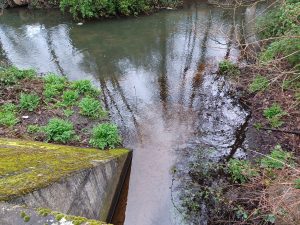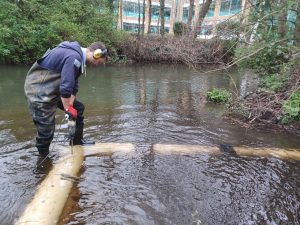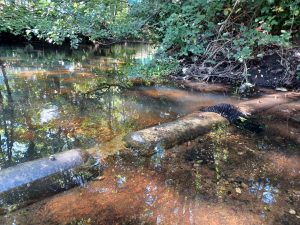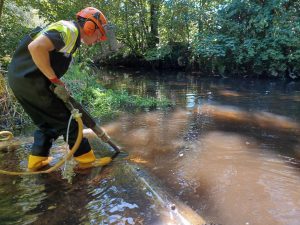Luke Beckett, one of our assistant project officers, reports on our latest river restoration work on the Blackwater Restoration Project. This has improved the ability of fish to move along the river, opening up a 4.5km stretch known as the Wish Stream tributary, where it meets the River Blackwater, in the north Hampshire stretch of the River Loddon.
Helping fish move between river sections

This was my first fish passage improvement since joining the South East Rivers Trust, so it was particularly fulfilling to deliver this work, which will help fish pass between the two watercourses and access good spawning habitat.
The River Blackwater, a tributary of the River Loddon which stretches across parts of Hampshire, Berkshire and Surrey, has long suffered from ‘poor’ fish classification status and only recently gained ‘good’ status. We aim to maintain or even exceed this status in the future and one way to contribute towards this is by improving the ability for fish to move easily between different sections.
The Wish Stream is an important semi-rural tributary of the River Blackwater, which supports a population of brown trout (Salmo trutta) and offers good spawning habitat in its lower reaches. Subsequently, improving connectivity between the Wish Stream and the River Blackwater is important for ensuring resilient fish populations in the catchment.
At the confluence of the two watercourses, we identified a concrete shelf which poses an obstruction to fish and eel movement, particularly during low-flow conditions.
Sloping notch and coping stones

The concrete shelf reduced the water depth, making it too shallow for fish to pass over. It also created a small weir between the Wish Stream and the River Blackwater during low-flow conditions, preventing fish moving up into the tributary. The smooth concrete also made it difficult for European eels to move along the river. This critically endangered species requires rougher substrates and slower flowing water to migrate along rivers.

To make this confluence more fish friendly, we created a sloping notch/ramp down the front of the concrete, allowing water to flow more naturally. The concrete was particularly hard – too hard for our machines and so we had to return with a hydraulic breaker to finish the notch.
In addition to this, we installed coping stones along the edge of the concrete to increase water depth over the shelf, enabling fish species to swim through. Finally, we improved the climbing substrate for European eels by adding an eel brush over the crest of the coping stones and safely down onto the concrete bed and vegetation upstream.
This passage improvement work was a relatively simple and straightforward delivery project. Most of it was completed in just over a day, although we had to wait until conditions were right to complete the final notch, and we were able to use coping stones which were left over from a previous project.
Great for brown trout and eels

The work enables fish, such as brown trout and European eels, to access important habitat for spawning and juvenile recruitment along the Wish Stream, which is roughly a 4.5km stretch of waterway.
It also allows mature individuals to disperse down into the River Blackwater and mix with other populations. With improved access to these habitats, fish numbers will hopefully increase and provide a greater prey source for other species such as kingfishers and herons.
Such improvement works show that sometimes it doesn’t take much to connect habitat and improve conditions for a range of species. I am looking forward to returning over the coming months to see these benefits. We hope this enhanced connectivity will strengthen fish populations in the catchment long into the future and I hope this is my first of many fish passage improvement deliveries.
